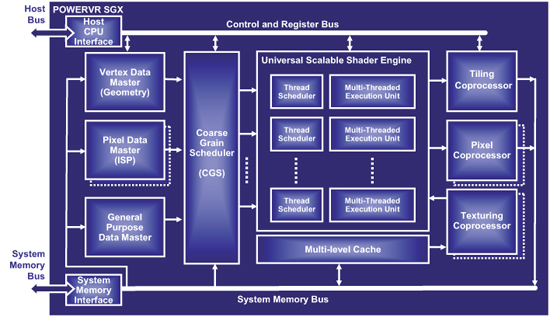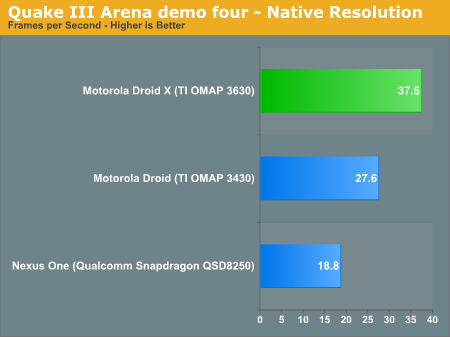Motorola Droid X: Thoroughly Reviewed
by Brian Klug on July 20, 2010 4:27 PM EST- Posted in
- Smartphones
- Motorola Droid X
- OMAP
- Mobile
The OMAP GPU - Powered by Imagination Technologies
TI continues to license its GPUs from Imagination Technologies. Rather than move to the PowerVR SGX 535 used by Apple and Intel, TI stuck with the same PowerVR SGX 530 core used in the OMAP 3430. The difference between the SGX 530 and 535 is as follows.
ImgTec refers to the execution hardware in its Series 5 GPUs as a Universal Scalable Shader Engine (USSE). Each USSE pipe can execute a 2-wide vector or up to a 4-way SIMD scalar op in a single clock. Both the SGX 530 and 535 have two USSE pipes from what I can tell.

The SGX 535 used in Apple’s A4 and Intel’s Atom Z600 series apparently have a second texturing unit and DirectX 9L support.
We’d expect that 3D apps on smartphones are more compute bound these days so it’s difficult to say how much you lose by going with the SGX 530 vs. 535. Until we get a Moorestown dev kit running Android we won’t be able to shed much light on that.
While the OMAP 3430 ran the GPU core at ~110MHz, the 3630 ramps it up to 200MHz. We’re seeing a lot of convergence around this 200MHz mark at 45nm. Intel runs the SGX 535 in Moorestown (Atom Z600 series) at 200MHz as well and I believe that’s what Apple uses in the A4 as well.
The 80% increase in GPU clock speed should result in significant real world GPU performance improvements. Just as with the CPU, there are no significant architectural changes to the GPU - it just runs faster.
The memory controller is still a 32-bit LPDDR1 interface, but can now run at up to 200MHz (the 3430 was limited to 166MHz). Should a customer choose to go for 200MHz LPDDR1 you’d get a 20% increase in memory bandwidth which will come in handy with the faster GPU in 3D apps for sure.
The GPU Performance Showdown: Snapdragon vs. OMAP 3630
When Brian first started cranking on the Droid X review he wanted to put the Qualcomm Adreno 200 vs. PowerVR SGX debate to rest. We had always reported that Qualcomm’s Snapdragon GPU was slower than the PowerVR SGX used in Apple’s A4 and TI’s OMAP 3, but we didn’t have a good idea of how much slower. Until now that is.
Armed with the Google Nexus One (Snapdragon QSD8250), Motorola Droid (OMAP 3430) and Motorola Droid X (OMAP 3630) all running Android 2.x (the N1 was running 2.2) we polished off one of the most popular GPU benchmarks of our time: Quake III Arena.
The kwaak3 project ported Q3A from a Nokia N900 version to Android. With a bit of elbow grease and getting around the lack of touchscreen keyboard support, we got the benchmark running. All scores were generated at default graphics quality settings and at native resolution, which unfortunately means the Droid X has around 7% more pixels to render than the other Android devices.

Even with the handicap, the 200MHz PowerVR SGX 530 core manages double the frame rate of the Adreno 200 in the Nexus One’s Snapdragon. Even the 110MHz SGX 530 is faster.
Here’s another interesting tidbit - we’re actually CPU bound on all of these platforms running demo four in Q3A:

Droid X (OMAP 3630) CPU utilization while running Quake III Arena
Intel is talking about greater than 100 fps frame rates with Atom Z600, meaning that the advantage is strictly on the CPU side. This also tells us that the PowerVR SGX 530 may even be a good fit for next year’s Cortex A9 based SoCs, even though TI has already committed to using the SGX 540 in its OMAP 4 line.
Neocore is another popular GPU benchmark, although this one is written for Qualcomm’s Adreno 200. The OpenGL ES 1.1 benchmark is mostly a GPU test but also stresses the platform as a whole. Running on our OMAP 3 based phones we see an average of 50% CPU utilization during the test.

The Droid X (OMAP 3630) CPU utilization while running Neocore
Interestingly enough, running the same test on a Snapdragon platform shows higher CPU utilization:

The Nexus One (Snapdragon) CPU utilization while running Neocore
The benchmark could be very well optimized for Qualcomm’s Scorpion core resulting in better CPU utilization compared to a Cortex A8.

The Adreno 200 in the Nexus One and EVO 4G outperforms the PowerVR SGX in the original Droid by 4 - 14%. This isn’t a surprise given the Qualcomm branding on the benchmark. The 45nm SGX 530 running at 200MHz puts all question to rest, the OMAP 3630 is 53% faster than Snapdragon.
The comparison here is obviously more than just GPU to GPU. We’re dealing with different CPU cores (ARM Cortex A8 vs. Qualcomm Scorpion), different memory controllers, different caches, and different drivers. Just as we’ve seen in the desktop GPU race, driver and benchmark optimizations have a lot to do with 3D performance results. I put more faith in the Quake 3 results, however those too came from a port optimized for PowerVR’s SGX.










89 Comments
View All Comments
czesiu - Tuesday, July 20, 2010 - link
great review!higher res version for this please:)
http://images.anandtech.com/doci/3826/DROIDX-Anand...
Brian Klug - Tuesday, July 20, 2010 - link
I'm actually going to dump all the screen comparison photos I've got (there are quite a few) into a gallery, then you can peruse at native resolution. Should be up in a little bit ;)-Brian
hatter_india - Tuesday, July 20, 2010 - link
Fantastic review but I expect no less from AnandTech. But there are a couple of bloopers:1- OMAP 3630 is third mobile chip to use 45nm process. First is of course A4. But second is Samsung's Hummingbird, a chip that the korean company designed with help of Intrinsity. This chip is found in Galaxy S or its variants. Samsung is the same company that also tweaked A4, which incidentally is fabbed by Samsung. Too many coincidences ;-)
2- A comparison to PowerVR SGX 540 found on Galaxy S would have been interesting as according to Samsung SGX 540 is almost three times more powerful than SGX535.
3- Droid X should have also been compared with Galaxy S or any of its variants like Captivate, Vibrant etc
hatter_india - Tuesday, July 20, 2010 - link
This line: Samsung is the same company that also tweaked A4, which incidentally is fabbed by SamsungShould read: Intrinsity is the same company that also tweaked A4, which incidentally is fabbed by Samsung
Goty - Tuesday, July 20, 2010 - link
Does AT have any plans to review any of the Galaxy S phones? I just picked up a Captivate on Sunday and I'd love to see how it stacks up. I just ran the Neocore benchmark and got around 55 FPS, which speaks well of the GPU, but I'd like to see results from the other tests you guys do.Brian Klug - Tuesday, July 20, 2010 - link
Hey Goty,We definitely have plans to do reviews of all of the Galaxy S phones we can get our hands on. I'm working on getting them as soon as possible ;)
I'm also pretty excited to explore that SoC and compare.
-Brian
Ram21 - Tuesday, July 20, 2010 - link
Really enjoyed this review. Keep up the great work! Being as thorough as you guys are really helps to make good decisions on purchases.SonicIce - Tuesday, July 20, 2010 - link
lol how long before we can attach an external mouse and keyboard to a phone to use it as a pc and play 3d games online with itstrikeback03 - Tuesday, July 27, 2010 - link
How about this?http://www.androidcentral.com/dell-streak-logitech...
ltfields - Tuesday, July 20, 2010 - link
Guys, another gold standard review. I may not be able to pick up an X because I'm still under contract with another carrier, but the reviews are riveting. Keep up the excellent work!